Potential Mechanism of Huangqi Guizhi Wuwu Decoction for Cervical Spondylosis treatment based on Network Pharmacology
2021-09-24LuYaoHuoTianXiaoFengBiFengFuJinSuJuckZhangYuanDongLiPingWang
Lu-Yao Huo,Tian-Xiao Feng,Bi-Feng Fu,Jin Su,Juck Zhang,Yuan-Dong Li,Ping Wang*
1First Teaching Hospital of Tianjin University of Traditional Chinese Medicine,Tianjin 300192,China;2National Clinical Research Center for Chinese Medicine Acupuncture and Moxibustion,Tianjin 300192,China.
Abstract Objective:To study the potential mechanism of Huangqi Guizhi Wuwu Decoction in the treatment of cervical spondylosis based on the network pharmacological method,and to provide a basis for clinical application and pharmacological research.Methods:TCMSP search was used to screen the main active compounds and related action targets of Huangqi Guizhi Wuwu Decoction,the standard names of action targets were obtained through the Uniprot database,and the"drug-target"interaction network was constructed by using Cytoscape3.6.1 software.The related targets of cervical spondylosis were obtained by searching GeneCards,OMIM,DisGeNET,and CTD databases,and the disease targets and drug targets were mapped by the Venny platform,and the intersection genes of them were the potential targets for drug treatment of this disease.Then,the intersection genes were input into the STRING database and Cytoscape 3.6.1 software,and the protein-protein interactions(PPI)network of"drug-disease intersection targets" was constructed,and we screened the core targets.Finally,GO biological function analysis and KEGG signaling pathway analysis of core targets were carried out through the DAVID database.Results:According to the screening conditions,74 effective compounds and 138 drug action targets of Huangqi Guizhi Wuwu Decoction were obtained,12179 genes related to cervical spondylosis were obtained,and the Venny platform analysis obtained 105 intersecting targets.With visual network processing by Cytoscape software,33 core targets were obtained by analyzing and calculating the core target degree values,which were JUN,PTGS2,NR3C1,TNF,IL6,TP53,EGFR,VEGFA,NOS3,IL1B,and so on.GO analysis showed that there were 133 items(P <0.05),involving adrenergic receptor activation,neurotransmitter receptor activation,nuclear receptor activation,catecholamine binding,etc.KEGG analysis obtained a total of 139 pathways(P <0.05),involving IL-17 signaling pathway,and tumor necrosis factor signaling pathway,relaxin signaling pathway,AGE-RAGE signaling pathway of diabetic complications,fluid shear stress,and atherosclerosis.Conclusion:the active components in Huangqi Guizhi Wuwu decoction may act on the core targets such as JUN,PTGS2,NR3C1,TNF,IL6,TP53,VEGFA through IL-17 signal pathway,tumor necrosis factor signal pathway,and AGE-RAGE signal pathway of diabetic complications,and exert their therapeutic effects.The research results can provide a basis for future basic and clinical research.
Key words:Network pharmacology,Huangqi Guizhi Wuwu Decoction,Cervical spondylosis,Mechanism of action
Background
Cervical Spondylosis(CS)is a common and frequently occurring disease,which is closely related to age,gender,posture,etc.[1−3].CS is a kind of modern medical research produces the principle change based problems,as the growth of the age,cell aging and degradation of matrix molecules accumulate,intervertebral disc water content decreased,nucleus pulposus fibrosis,flexibility and strength decrease[4].The compressive and buffering capacity is reduced,improper posture for a long time the external effect of stress distribution around the intervertebral disc.In turn,it leads to pathological changes such as annulus fibrosus rupture,nucleus pulposus herniation,osteophyte hyperplasia and so on,and causes clinical symptoms such as pain,numbness and vertigo due to damage to nerve roots and vertebral arteries.The conservative treatment for CS includes physical therapy,traction massage,acupuncture,blocking therapy,NSAIDs anti-inflammatory analgesic and internal administration of traditional Chinese medicine.Traditional Chinese medicine has the advantages of low risk,small side effects,low price,good efficacy,etc.in the treatment of CS.Huangqi Guizhi Wuwu Decoction is the most used decoction[5].Sun Changsheng[7]et al.treated vertebral artery type cervical spondylosis with Huangqi Guizhi Wuwu Decoction combined with traction and electricity.The results showed that the clinical symptoms and signs of patients could be significantly improved,with a total effective rate of 94.5%.Tan Jie[8]et al.treated 30 patients with cervical spondylotic radiculopathy with Huangqi Guizhi Wuwu Decoction combined with acupoint injection.Among them,12 were significantly effective,17 were effective and 1 was ineffective,with a total effective rate of 96.67%.Chen Chaoyun[9]et al.also showed that Huangqi Guizhi Wuwu Decoction could improve the clinical symptoms of cervical spondylosis and reduce the VAS score.However,the mechanisms and main ingredients of Huangqi Guizhi Wuwu Decoction for CS treatment were not deep researched.Based on systems biology,multidirectional pharmacology,bioinformation technology,computer technology,network pharmacology is a new research methods for multi-ingredients and multi-targets durgs[10,11].This study explored the potential mechanism of Huangqi Guizhi Wuwu Decoction in CS treatment,in order to provide a modern theoretical basis and scientific basis for the clinical application of this prescription.
Materials and methods
Screening of main compounds in Huangqi Guizhi Wuwu Decoction
On the pharmacological analysis platform of the Traditional Chinese Medicine System Pharmacology(TCMSP,http://tcmspw.com/tcmsp.php),the main compounds in Huangqi Guizhi Wuwu Decoction were collected by searching with Astragalus membranaceus(Huangqi,Hedysarum Multijugum Maxim),Cassia twig(Guizhi,Cinnamomi Ramulus),Paeonia(Baishao,Paeoniae Radix Alba),Jujube(Dazao,Jujubae Fructus)and Ginger(Shengjiang,Zingiber Officinale Roscoe)as keywords.Huangqi Guizhi Wuwu Decoction is taken orally as the dominant form of medication,so oral bioavailability(OB)≥30% is set as one of the screening conditions[12];Compounds with higher drug likeness(DL)properties can go through multiple biological processes and reach the target cells to exert their effects,so DL ≥ 0.1 is set as the screening condition[13].According to OB and DL,it filtered the compounds with chief activity and high clinical application value out,and they established the database of related compounds in Huangqi Guizhi Wuwu Decoction.
Acquisition of gene names of main compound effect targets and disease-related targets
The possible targets of the main compounds in Huangqi Guizhi Wuwu Decoction were searched in TCMSP database by inputting the target data into Uniport database.Then,the genes related to cervical spondylosis are searched by "cervical spondylosis" as the keyword through GeneCards,OMIM,DisGeNE,CTD and other databases.
Build a"drug-target"PPI network
The drugs of Huangqi Guizhi Wuwu Decoction and the corresponding targets of each drug were input into STRING database(search tool for the retrieval of interacting genes/proteins,https://string-db.org/)and Cytoscape3.6.1 software(http://www.cytoscape.org/)to construct the interaction network diagram between drugs and target proteins.
Determination of common drug-disease targets and screening of core targets
To clarify the effect of Huangqi Guizhi Wuwu Decoction in treating cervical spondylosis,Venny 2.1(http://bioinfogp.cnb.sic.es/tools/venny/index.html)platform was used to compare and analyze the effect targets of Huangqi Guizhi Wuwu Decoction with those related to cervical spondylosis.Venny diagram showed the number of intersection targets.The common target of Huangqi Guizhi Wuwu Decoction and cervical spondylosis may be the therapeutic target of drugs acting on diseases.The gene names of common targets are input into the STRING database to obtain target-protein interaction network,then the obtained data are visualized by Cytoscape3.6.1 software,and the PPI visualization network diagram of"drug-disease common targets" is constructed.Using the "Network Analyzer" function in Cytoscape3.6.1 software,the target Degree and other information are compared and analyzed,and the screening result is higher.
Analysis of biological function and signal pathway of common target
The common targets of drugs and diseases obtained from the above screening were input into DAVID database(https://david.ncifcrf.gov/).The thresholdP<0.05 was set for GO biological function enrichment analysis and KEGG pathway annotation analysis,and the bubble diagram of enrichment analysis results was drawnbyOmicshareplatform(http://www.omicshare.com/tools/index.php/).
Results
Screening of main active compounds in Huangqi Guizhi Wuwu Decoction
Huangqi Guizhi Wuwu Decoction is taken orally as the dominant form of medication,so OB ≥30% is set as one of the screening conditions[12];Compounds with higher DL properties can go through multiple biological processes and reach the target cells to exert their effects,so DL ≥ 0.1 is set as the screening condition[13].According to OB and DL,we filtered the compounds with high activity and clinical application value out,and then established the database of related compounds in Huangqi Guizhi Wuwu Decoction.With OB ≥ 30% and DL ≥ 0.18 as screening conditions,74 main active compounds were screened out through TCMSP platform,including 20
Hedysarum Multijugum Maxim,7 Cassia twig,13 Paeonia,5 Ginger and 29 Jujube(Table 1).
Table 1 Basic information of some compounds in Huangqi Guizhi Wuwu Decoction

DrugLatin nameMol IDMolecule NameOB%DL%Astragalus membranaceus HedysarumMultij ugumMaximMOL000398isoflavanone109.990.3 Astragalus membranaceus Astragalus membranaceus Astragalus membranaceus Astragalus membranaceus Astragalus membranaceus HedysarumMultij ugumMaximMOL000417Calycosin47.750.24 HedysarumMultij ugumMaximMOL000422kaempferol41.880.24 HedysarumMultij ugumMaximMOL000433FA68.960.71 HedysarumMultij ugumMaximMOL000438(3R)-3-(2-hydroxy-3,4-dimethoxyphenyl)c hroman-7-ol67.670.26 HedysarumMultij ugumMaximMOL000439isomucronulatol-7,2'-di-O-glucosiole49.280.62 Astragalus membranaceus Hedysarum Multijugum Maxim MOL0004421,7-Dihydroxy-3,9-dimethoxy pterocarpene39.050.48 Astragalus membranaceus HedysarumMultij ugumMaximMOL000098quercetin46.430.28 Cassia twigCinnamomi RamulusMOL001736(-)-taxifolin60.510.27 Cassia twigCinnamomi RamulusMOL000358beta-sitosterol36.910.75 Cassia twigCinnamomi RamulusMOL000359sitosterol36.910.75 Cassia twigCinnamomi RamulusMOL000492(+)-catechin54.830.24 Cassia twigCinnamomi RamulusMOL000073ent-Epicatechin48.960.24 Cassia twigCinnamomi RamulusMOL004576taxifolin57.840.27 Cassia twigCinnamomi RamulusMOL011169Peroxyergosterol44.390.82 PaeoniaPaeoniae Radix AlbaMOL001910 11alpha,12alpha-epoxy-3beta-23-dihydrox y-30-norolean-20-en-28,12beta-olie64.770.38 PaeoniaPaeoniae Radix AlbaMOL001918paeoniflorgenone87.590.37 PaeoniaPaeoniae Radix AlbaMOL001919(3S,5R,8R,9R,10S,14S)-3,17-dihydroxy-4,4,8,10,14-pentamethyl-2,3,5,6,7,9-hexahy dro-1H-cyclopenta[a]phenanthrene-15,16-dione 43.560.53 PaeoniaPaeoniae Radix AlbaMOL001921Lactiflorin49.120.8
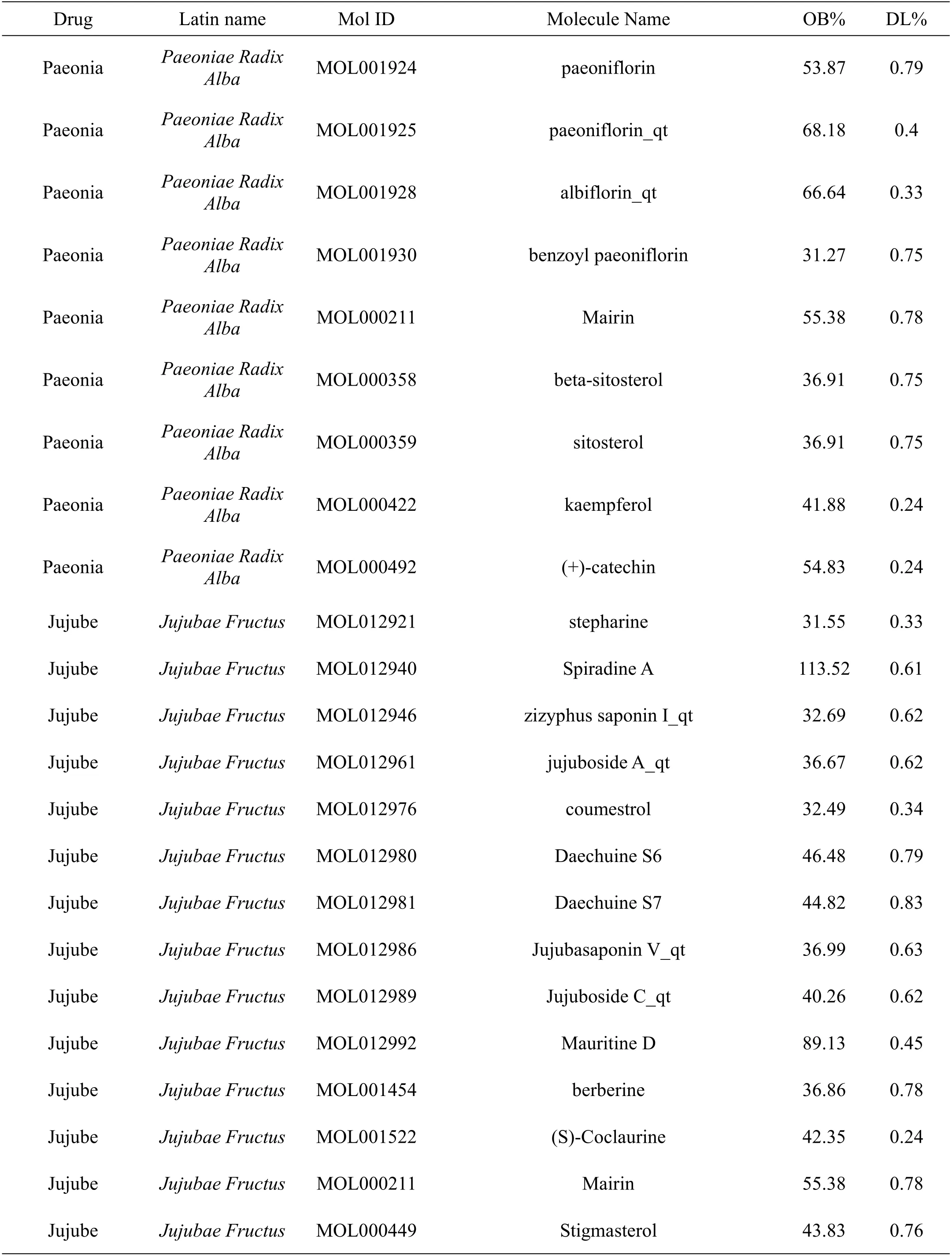
DrugLatin nameMol IDMolecule NameOB%DL%PaeoniaPaeoniae Radix AlbaMOL001924paeoniflorin53.870.79 PaeoniaPaeoniae Radix AlbaMOL001925paeoniflorin_qt68.180.4 PaeoniaPaeoniae Radix AlbaMOL001928albiflorin_qt66.640.33 PaeoniaPaeoniae Radix AlbaMOL001930benzoyl paeoniflorin31.270.75 PaeoniaPaeoniae Radix AlbaMOL000211Mairin55.380.78 PaeoniaPaeoniae Radix AlbaMOL000358beta-sitosterol36.910.75 PaeoniaPaeoniae Radix AlbaMOL000359sitosterol36.910.75 PaeoniaPaeoniae Radix AlbaMOL000422kaempferol41.880.24 PaeoniaPaeoniae Radix AlbaMOL000492(+)-catechin54.830.24 JujubeJujubae FructusMOL012921stepharine31.550.33 JujubeJujubae FructusMOL012940Spiradine A113.520.61 JujubeJujubae FructusMOL012946zizyphus saponin I_qt32.690.62 JujubeJujubae FructusMOL012961jujuboside A_qt36.670.62 JujubeJujubae FructusMOL012976coumestrol32.490.34 JujubeJujubae FructusMOL012980Daechuine S646.480.79 JujubeJujubae FructusMOL012981Daechuine S744.820.83 JujubeJujubae FructusMOL012986Jujubasaponin V_qt36.990.63 JujubeJujubae FructusMOL012989Jujuboside C_qt40.260.62 JujubeJujubae FructusMOL012992Mauritine D89.130.45 JujubeJujubae FructusMOL001454berberine36.860.78 JujubeJujubae FructusMOL001522(S)-Coclaurine42.350.24 JujubeJujubae FructusMOL000211Mairin55.380.78 JujubeJujubae FructusMOL000449Stigmasterol43.830.76

DrugLatin nameMol IDMolecule NameOB%DL%JujubeJujubae FructusMOL003410Ziziphin_qt66.950.62 JujubeJujubae FructusMOL000358beta-sitosterol36.910.75 JujubeJujubae FructusMOL004350Ruvoside_qt36.120.76 JujubeJujubae FructusMOL000492(+)-catechin54.830.24 JujubeJujubae FructusMOL005360malkangunin57.710.63 JujubeJujubae FructusMOL000627Stepholidine33.110.54 JujubeJujubae FructusMOL007213Nuciferin34.430.4 JujubeJujubae FructusMOL000783Protoporphyrin30.860.56 JujubeJujubae FructusMOL000787Fumarine59.260.83 JujubeJujubae FructusMOL00803421302-79-473.520.77 JujubeJujubae FructusMOL008647Moupinamide86.710.26 JujubeJujubae FructusMOL002773beta-carotene37.180.58 JujubeJujubae FructusMOL000096(-)-catechin49.680.24 JujubeJujubae FructusMOL000098quercetin46.430.28 JujubeJujubae FructusMOL013357(3S,6R,8S,9S,10R,13R,14S,17R)-17-[(1R,4R)-4-ethyl-1,5-dimethylhexyl]-10,13-dim ethyl-2,3,6,7,8,9,11,12,14,15,16,17-dodeca hydro-1H-cyclopenta[a]phenanthrene-3,6-diol 34.370.78 Ginger Zingiber Officinale Roscoe MOL000358beta-sitosterol36.910.75 Ginger Zingiber Officinale Roscoe MOL0061296-methylgingediacetate248.730.32 Ginger Zingiber Officinale Roscoe MOL000449Stigmasterol43.830.76 Ginger Zingiber Officinale Roscoe MOL001771poriferast-5-en-3beta-ol36.910.75 Ginger Zingiber Officinale Roscoe MOL008698Dihydrocapsaicin47.070.19
Drug-target network construction
Through the TCMSP database,the 74 main compounds mentioned above were searched for the effect targets of the main active components of Huangqi Guizhi Wuwu Decoction,and 427 action targets were obtained,of which 138 unique values were retained after removing duplication(Table 2).Cytoscape3.6.1 constructed the"drug-target"software.The obtained network(Figure 1)has 73 nodes(including 68 targets and 5 traditional Chinese medicine drugs)and 279 sides(yellow represents the drugs composed of Huangqi Guizhi Wuwu Decoction,blue represents the effect targets,red lines represent the interaction between drugs and targets,and blue lines represent the interaction between targets.)

Table 2 Effective targets of effective compounds in Huangqi Guizhi Wuwu Decoction
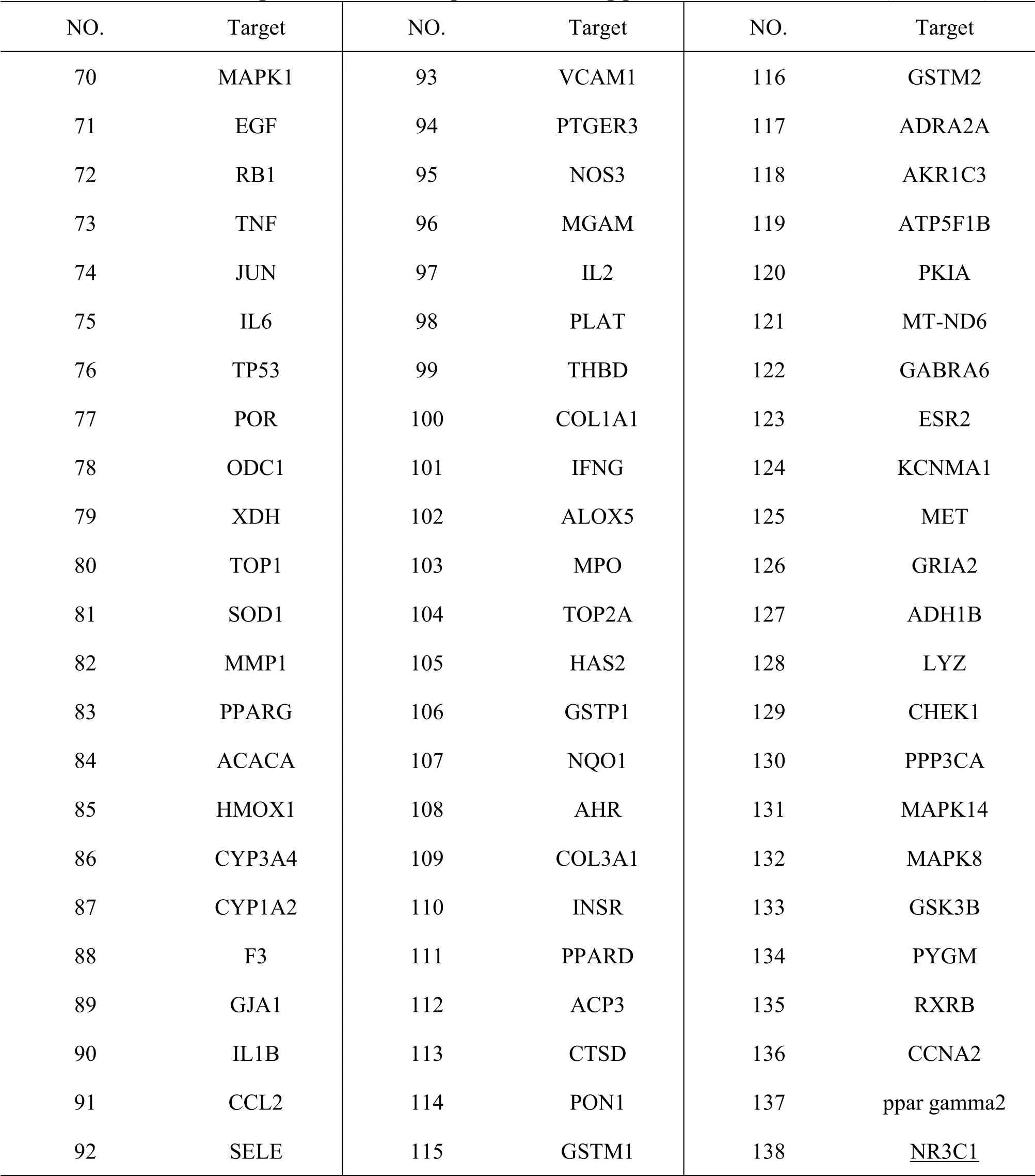
Table 2 Effective targets of effective compounds in Huangqi Guizhi Wuwu Decoction(continued)
The predicted targets for CS treatment
The GeneCards,OMIM,DisGeNET and CTD databases were used to search the target genes related to cervical spondylosis,and 12,596 target genes related to cervical spondylosis were obtained,and 12,179 target genes remained consistent after weight reduction.Using Venny 2.1 platform,the effect targets of the main components of Huangqi Guizhi Wuwu Decoction were mapped with the targets related to cervical spondylosis,and we obtained 105 common targets(Figure 2).
Drug-disease common target interaction network and core target screening
105 intersection genes obtained by mapping drugs and diseases are analyzed by PPI network on STRING platform,and then the obtained network relations are visualized by Cytoscape3.6.1 software.The core network diagram(Figure 3)contains 92 nodes and 306 edges.The larger the node graph,the more targets related to the node.Each edge is the interaction between target points,and the more and thicker the lines,the greater the correlation.The mean NOS3 degree of target protein was calculated to be 6.63 by network analysis,and 33 target proteins were exceeding the mean degree value,which was JUN(transcription factor AP-1),PTGS2(prostaglandin G/H synthase 2),NR3C1(glucocorticoid receptor),TNF(tumor necrosis factor),IL6(interleukin -6),IL1B(interleukin-1β),and IL-1 B.In the network,the degree of a node indicates the number of routes related to the node.According to the topological properties of the network,we select the nodes with higher degree value,which are related to more targets.Therefore,it is speculated that these 33 targets are the key targets in the network,and the molecular mechanism of Huangqi Guizhi Wuwu Decoction in treating cervical spondylosis is probably exerted by acting on these targets.
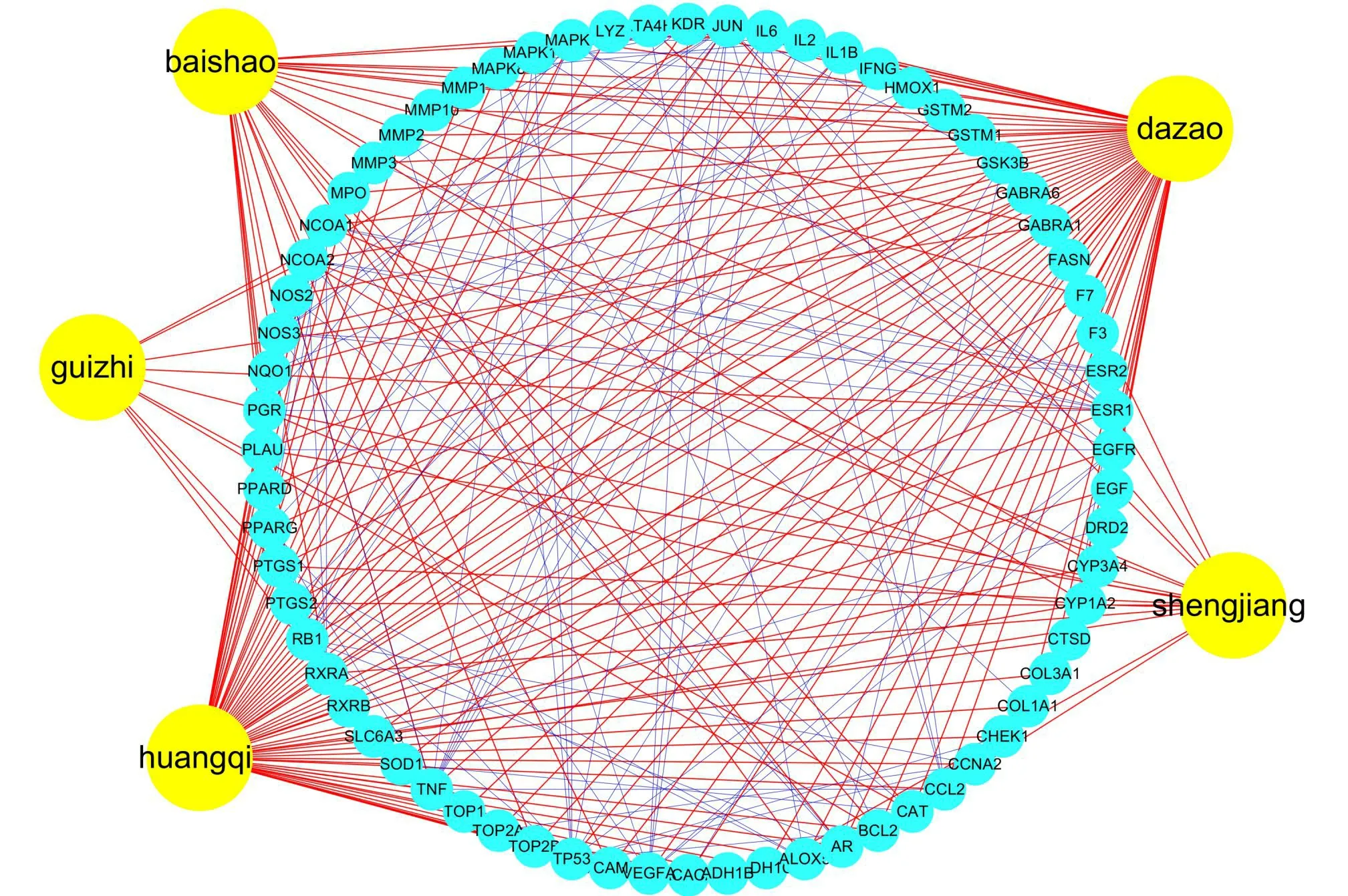
Figure 1 Drug-target network
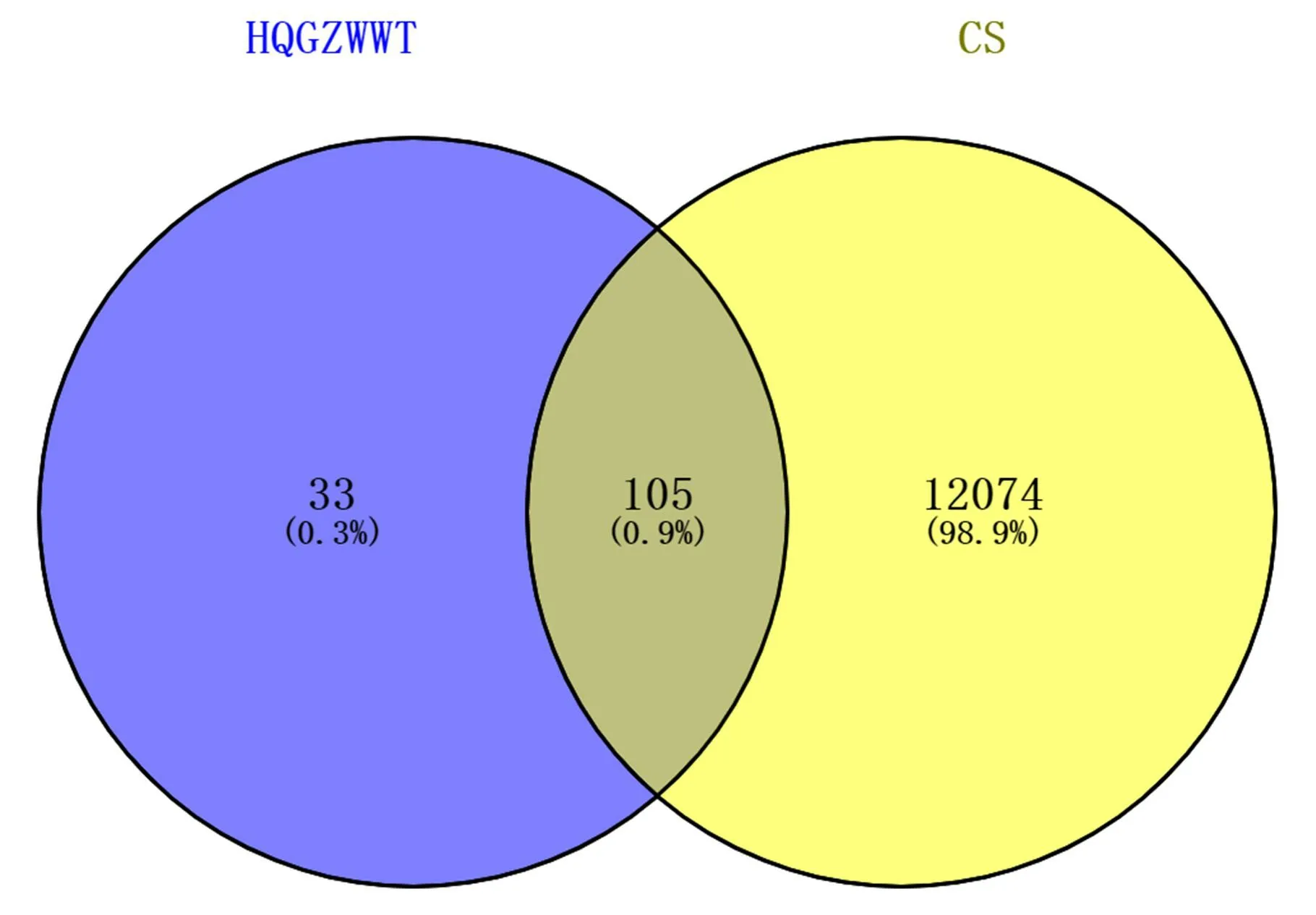
Figure 2 Venny diagram of common drug-disease target
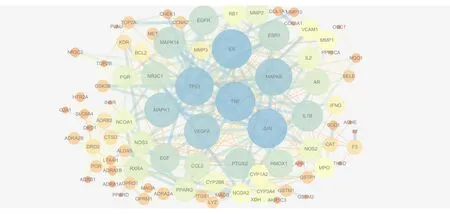
Figure 3 Drug-disease common target interaction network
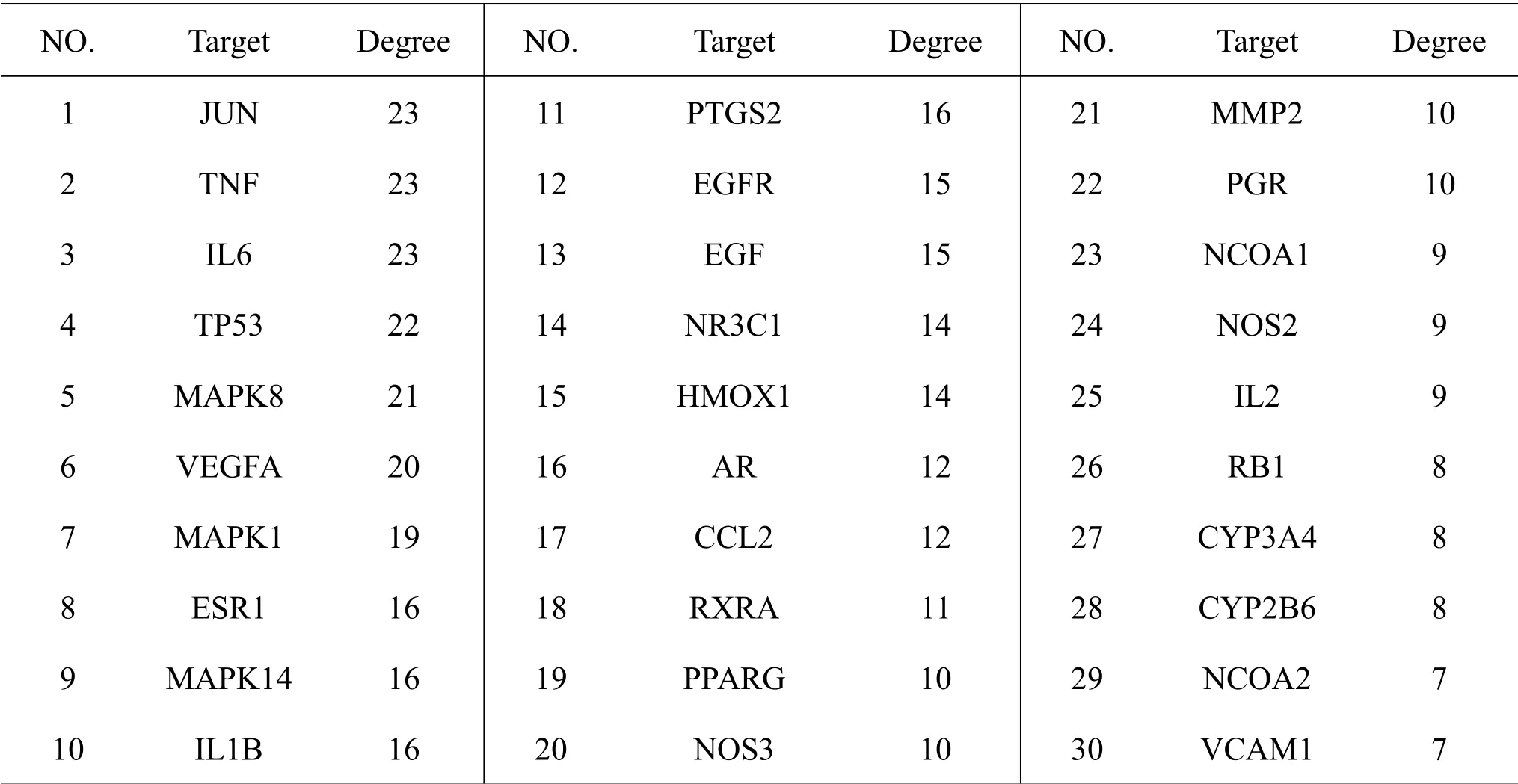
Table 3 Information table of key action targets
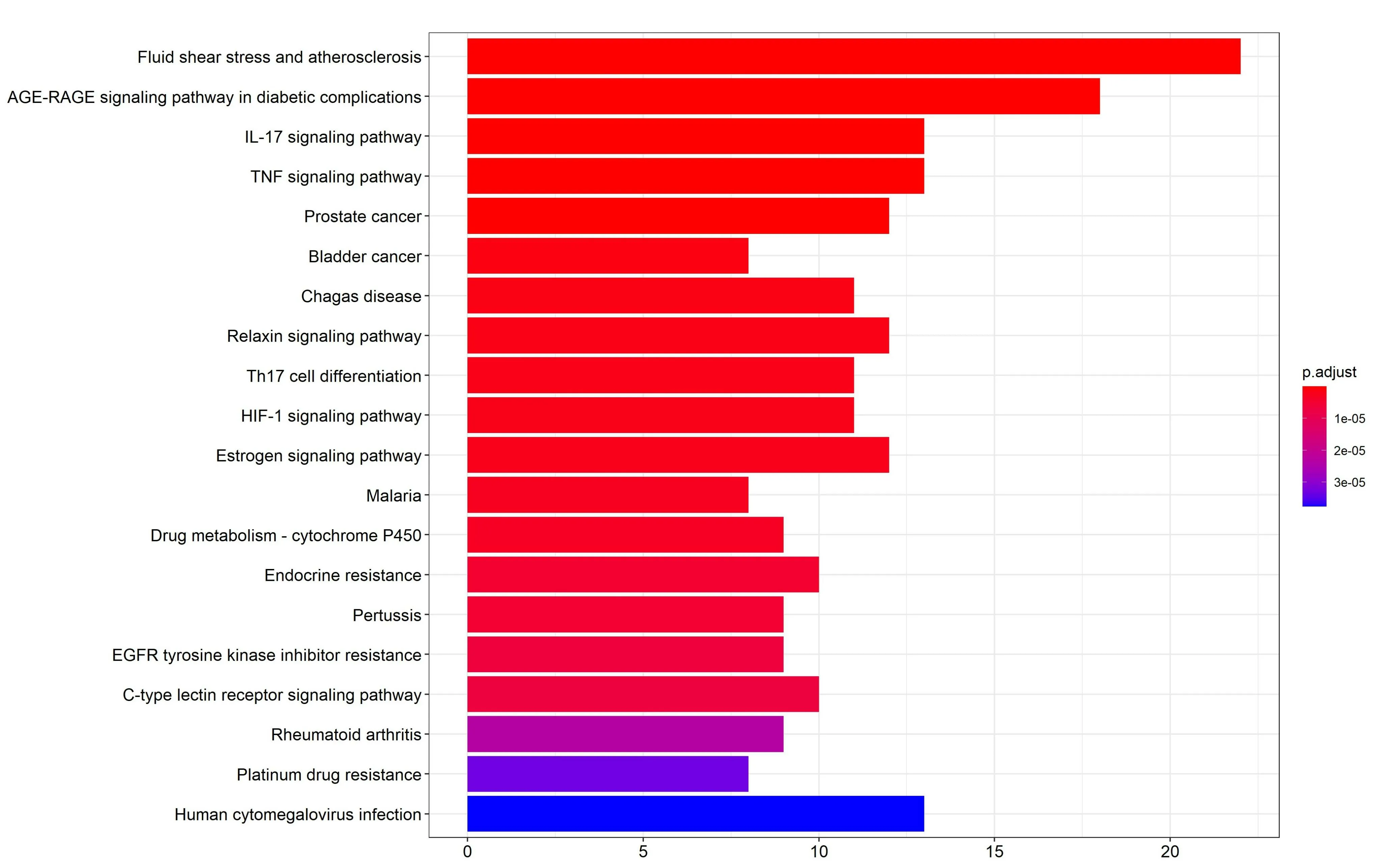
Figure 4 GO enrichment analysis chart of common drug-disease target
Common target biological function and signal pathway analysis
The 105 common targets obtained above were analyzed for GO function and KEGG signaling pathway by David database.A total of 133 gene function items with significant significance(P<0.05)were obtained.The top 20 GO items with high gene enrichment number were screened to draw histogram and bubble diagram,as shown in Figure 4.Among them,amide binding,adrenergic receptor activity,neurotransmitter receptor activity and nuclear receptor activation were observed Receptor activity),catecholamine binding,and G protein-coupled amine receptor activity),steroid hormone receptor activity,heme binding and antioxidant activity were concentrated.A total of 139 KEGG pathways with significant significance(P<0.05)were obtained by enrichment screening,and 20 items with high gene enrichment number were plotted with histogram and bubble diagram.Among them,the number of genes in the IL-17 signaling pathway,tumor necrosis factor signaling pathway,and Relaxin signaling pathway are identified,as shown in Figure 5.

Figure 5 KEGG pathway analysis diagram of drug-disease common target
Discussion
According to the theory of Traditional Chinese Medicine,cervical spondylosis belongs to the category of "arthralgia syndrome",and the invasion of exogenous pathogens,viscera deficiency,and improper posture are the important pathogenic factors.Western medicine believes that the pathogenesis is that under the action of age,chronic strain,local cold,and trauma,the intervertebral disc degenerates,the water content of nucleus pulposus decreases,the stress balance of cervical spine structure are broken,and the stress distribution is uneven.On the one hand,the mechanical changes lead to the rupture of the weak part of the annulus fibrosus,the protrusion of the nucleus pulposus,and the compression of nerve roots and spinal cord;Osteophytes proliferate along the direction of stress concentration,which can also cause compression on surrounding tissues,and then appear clinical symptoms and signs.
Huangqi Guizhi Wuwu Decoction has various target types and contains complex chemical components,action targets,action pathways,and physiological functions[14−18],which is a classic prescription for numbness and pain treatment.In this study,33 core targets such as IL6,TNF,VEGFA,JUN,TP53,IL-1β,MAPK14,MAPK3,PTGS2 were obtained through PPI protein interaction network analysis,which involved inflammatory reaction,ischemia and hypoxia,neurovascular regeneration,cell proliferation,and apoptosis.Among them,IL-6,IL-1β,TNF,and PTGS2 are important inflammatory cytokines,which are closely related to inflammation-mediated nerve injury.Various pro-inflammatory factors can aggravate the inflammatory injury of a cervical intervertebral disc,nerve root,and surrounding soft tissue through interaction,which is an important link in the pathological process of cervical spondylosis[19,20]VEGFA(vascular endothelial growth factor A)mainly,regulates angiogenesis and nerve regeneration.VEGFAVEGFR2 signal pathway induced by ischemia and hypoxia of nerve root caused by protrusion compression is the fundamental way to mediate angiogenesis and nerve regeneration,which plays an important role in improving microcirculation.MAPK14andMAPK3aremembersof mitogen-activated protein kinases,which can be activated under oxidative stress and DNA damage.MAPK can mediate biological processes such as inflammatory reaction and apoptosis,and can also play a role in the human coagulation and fibrinolysis system through ERK,p38MAPK,and SAPKJNK pathways[21,22].JUN(transcription factor AP-1)is the coding product of nuclear proto-oncogene c-jun,which has the biological activity of regulating cell growth,differentiation,and apoptosis[23,24].Studies have shown that osteoclast differentiation can receive the c-jun gene and promote the expression of JUN[25],which also proves that degeneration is an important influencing factor in the pathogenesis of cervical spondylosis.TP53 can regulate the growth and metabolism of tumor cells and play an important role in cell proliferation and apoptosis[26].According to the effects of the above core targets,it is speculated that Huangqi Guizhi Wuwu Decoction may play a role in the inflammatory reaction,neurovascular regeneration,apoptosis,etc.by acting on the targets such as IL6,TNF,VEGFA,JUN,TP53,IL-1β,MAPK14,PTGS2,MAPK3,etc.This prescription play amulti-facetedandsystematicrolein anti-inflammatory,anti-oxidation,analgesia,immune regulation,and improvement of microcirculation and hemorheology.It embodies the scientific compatibility of Chinese medicine "monarch,minister,assistant and envoy",which is consistent with the whole idea.The targets such as IL6,TNF,VEGFA,JUN,TP53,IL-1β,MAPK14,PTGS2,MAPK3 also provide new ideas for the future clinical application and pharmacological research of this prescription.
The result of GO functional enrichment analysis showed that the gene function of Huangqi Guizhi Wuwu Decoction in treating cervical spondylosis is mainly concentrated in adrenergic receptor activity,neurotransmitter receptor activity,nuclear receptor activity,Catecholamine binding,G-protein-coupled amine receptor activity,steroid hormone receptor activity,and so on,which embody the biological functions of anti-inflammation,anti-oxidation and improving microcirculation.The results of KEGG signaling pathway enrichment analysis show that the inflammatory signaling pathway mainly includes the TNF signaling pathway and IL-17 signaling pathway[27−29],which may hint he important pathological processes in the pathogenesis of cervical spondylosis.Huangqi Guizhi Wuwu Decoction eliminates pathological factors from the molecular level and embodies the concept of "seeking the root of treating diseases" in traditional Chinese medicine.AGE-RAGE signaling pathways in diabetic complications,fluid shear stress,and atherosclerosis are also important pathways.AGE-RAGE(advanced glycation end products and their receptors)signal pathway can cause oxidative stress reaction,which leads to lipid peroxidation of biofilm,denaturation of intracellular proteins and enzymes,DNA damage,and so on,and finally leads to cell tissue damage.MAPK pathway and NF-κB pathway are also activated,and the expression and release of pro-inflammatory factors and growth factors are promoted,resulting in damage to blood vessels and cells.Abnormal shear stress of blood flow is an important factor causing vascular degeneration,and vascular injury often leads to insufficient blood supply and dizziness.
According to the relevant targets and gene enrichment results,it can be speculated that the active ingredients in Huangqi Guizhi Wuwu Decoction may act on the targets of IL6,TNF,VEGFA,JUN,TP53,IL-1β,MAPK14,HMOX1,PTGS2,MAPK3,CCL2,NOS3,etc.through fluid shear stress and atherosclerosis,AGE-RAGE signal pathway,TNF signal pathway,etc.The effects of protecting blood vessels and nerve tissues,regulating immunity,improving microcirculation,etc.,suggest that Huangqi Guizhi Wuwu Decoction has potential therapeutic effect and relevance on symptoms such as insufficient blood supply,inflammatory reaction,abnormal nerve sensation,etc.,which lays a foundation for clinical application and pharmacological research of this prescription in the future.
